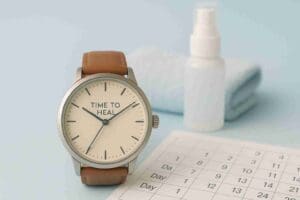While the modern treatments for hair loss are highly effective, with up to a 98% success rate, it’s not just a matter of getting the surgery. Hair transplant aftercare is just as important, as you want to make sure that everything is healing properly and that you minimize the risk of damaging the donor follicle.
We will go over the basic things to look out for during each phase of the process and what you need to do. Of course, you can always contact the clinic if you have any additional questions or issues, as the doctors will be monitoring your progress and providing proper guidance.
Immediate Post-Op Care (Day 0 to Day 3)
Right after the operation, you will spend a few hours at the hair transplant clinic so that the doctor can make sure that you are not experiencing any complications and that everything is going well. Most high-end clinics will provide a PRP session during this time and an additional one the day after, to help speed up the healing process.
Hydration and the basics
Before your return flight, you will also get an aftercare bag with all the essentials you will need, and the doctor will give you some detailed instructions you need to follow.
For the first 12 hours, you will need to use a spray bottle to gently apply a saline solution to avoid hair graft infections and excessive scabs, and then get plenty of sleep.
Proper rest and hygiene
The head shouldn’t come in contact with pillows, headboards, or clothes for the first few days, so you will need to wear buttoned shirts and use a neck pillow to keep your head at a slight upward angle as you sleep. This will also help reduce the initial swelling.
After 48 hours, you can start applying the special product provided by the clinic, lightly dabbing it with your fingertips, and rinsing with lukewarm water poured from a cup – don’t use a showerhead as the pressure is too intense for the scalp at this stage.
Dealing with swelling and what to avoid
Wearing a light headband around the forehead and applying ice packs for a few minutes throughout the day will also help keep the swelling from moving down towards your eyes. Refrain from any strenuous physical activity and bending below the waist level, and avoid smoking, alcohol, and blood-thinning medication during this time.
The First Week (Day 4 to Day 7)
At around day five post hair transplant, you can begin washing your hair under a warm, light-pressure shower, but you should still avoid standard shampoos, as well as any exercise and alcohol.
You must also avoid direct sun exposure and rain at all costs, so use a parasol or umbrella if you have to go outside in hot or rainy weather, but try to stay inside and rest as much as possible.
The good news is that the recovery process will be coming along nicely, and most of the pain and swelling should be gone by the end of the first week.
As a FUE hair transplant involves making lots of tiny incisions in the scalp, the transplanted area will be itchy, so you will have to avoid scratching, though you can use anti-irritation creams for babies to keep it under control.
Post-Surgery Care Tips (Week 2 to Week 4)
The scalp at the recipient and donor areas will still be pinkish and scabbed over by around week two, at which point all the scabs should fall off on their own as you shower, though it may take another week for people with really pale skin.
At this point, you can start using shampoos with natural ingredients, as well as argan and coconut oil, as part of your post operative care.
1 to 3 Months Post-Transplant
The main thing you will notice is that all the hair from the transplanted grafts will fall off, leaving you with the same appearance as you had before the surgery, but that is normal.
It’s important to keep eating a healthy diet full of fruit and vegetables, and relatively low in fat, and take multivitamins if you have a nutrient deficiency. Also, avoid swimming and contact sports.
Small white spots may appear by the third month, but these will slowly open up and turn red as the new hair begins to grow.
3 to 6 Months After Surgery
This is where you should contact the clinic for a check up and send pictures so the doctors can see how you are progressing and give you any additional advice if needed. The new hair will still be a bit thin and wispy, but there should be plenty of visible growth six months in.
6 to 12 Months Post-Transplant
This is when the individual hairs will become thick and strong, and you will see full hair transplant recovery within a year after surgery. The final results should be a full head of hair with a youthful hairline.

FAQs
Can I wear a cap or helmet?
You should avoid any headwear for the first three months after the operation to give the grafts enough time to fully strengthen, but after that, you can return to your normal routine.
Why are my grafts falling out?
The hair is just going through its normal cycle – the follicles have just entered their exogen phase, where old strands fall out to make room for new hair growth. This just means that you can expect stronger hairs to grow out within the upcoming months.
Can I have sex after a transplant?
Doctors generally advise that you abstain from any sexual activity, along with sports and other physically demanding tasks, for 12 to 14 days after a hair transplant in turkey. That’s because such activities increase your body temperature and the blood flow to the head, which can interfere with the proper growth of the grafts.
When can I use hair products again?
It’s best to avoid these for at least the first month, so as not to irritate the scalp, but you should generally avoid these for about two months, just to be on the safe side.
Is it safe to expose my scalp to the sun?
Hair transplants take time to heal up properly, so direct sun exposure should be avoided during the first month. After this, it’s not a big problem, but still try to limit it and use sunscreen.

